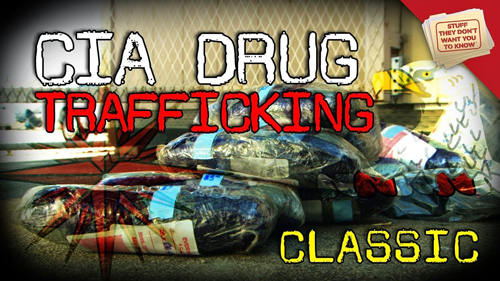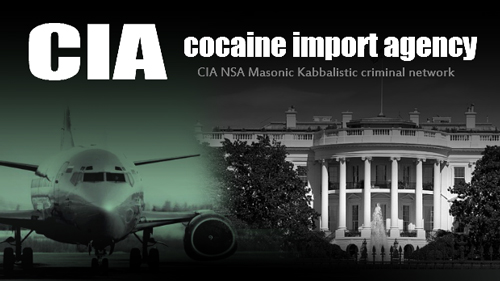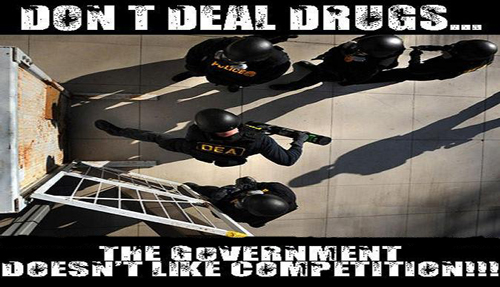Narcotics and Covert Intelligence: How the CIA Commandeered the War on Drugs (4)
Read the third part of the article
The Cover-Up
Despite the flurry of investigations, Nixon’s successor, Gerald Ford, reconfirmed the CIA’s narcotic intelligence collection arrangement with DEA, and the CIA continued to have its way. Much of its success is attributed to Seymour Bolten, whose staff handled “all requests for files from the Church Committee,” which concluded that allegations of drug smuggling by CIA assets and proprietaries “lacked substance.”

The Rockefeller Commission likewise gave the CIA a clean bill of health, falsely stating that the Twofold inspections project was terminated in 1973. The Commission completely covered-up the existence of the operation unit hidden within the inspections program.
Ford did task the Justice Department to investigate “allegations of fraud, irregularity, and misconduct” in the DEA. The so-called DeFeo investigation lasted through July 1975, and included allegations that DEA officials had discussed killing Omar Torrijos and Manuel Noriega. In March 1976, Deputy Attorney General Richard Thornburgh announced there were no findings to warrant criminal prosecutions.
In 1976, Congresswoman Bella Abzug submitted questions to new Director of Central Intelligence George H.W. Bush, about the CIA’s central role in international drug trafficking. Bush’s response was to cite a 1954 agreement with the Justice Department gave the CIA the right to block prosecution or keep its crimes secret in the name of national security.
In its report, the Abzug Committee said: “It was ironic that the CIA should be given responsibility of narcotic intelligence, particularly since they are supporting the prime movers.”
The Mansfield Amendment of 1976 sought to curtail the DEA’s extra-legal activities abroad by prohibiting agents from kidnapping or conducting unilateral actions without the consent of the host government. The CIA, of course, was exempt and continued to sabotage DEA cases against its movers, while further tightening its stranglehold on the DEA’s enforcement and intelligence capabilities.
In 1977, the DEA’s Assistant Administrator for Enforcement sent a memo, co-signed by the six enforcement division chiefs, to DEA chief Peter Bensinger. As the memo stated, “All were unanimous in their belief that present CIA programs were likely to cause serious future problems for DEA, both foreign and domestic.”
They specifically cited controlled deliveries enabled by CIA electronic surveillance and the fact that the CIA “will not respond positively to any discovery motion.” They complained that “Many of the subjects who appear in these CIA – promoted or controlled surveillances regularly travel to the United States in furtherance of their trafficking activities.” The “de facto immunity” from prosecution enabled the CIA assets to “operate much more openly and effectively.”
But then DEA chief Peter Bensinger suffered the CIA at the expense of America’s citizens and the DEA’s integrity. Under Bensinger the DEA created its CENTAC program to target drug trafficking organization worldwide through the early 1980s. But the CIA subverted the CENTAC: as its director Dennis Dayle famously said, “The major targets of my investigations almost invariably turned out to be working for the CIA.”
Murder and Mayhem
DEACON 1 inherited BUNCIN’s anti-Castro Cuban assets from Brigade 2506, which the CIA organized to invade Cuba in 1960. Controlled by Nixon’s secret political police, these CIA assets, operating under DEA cover, had parallel assignments involving “extremist groups and terrorism, and information of a political nature.”
Noriega and Moises Torrijos in Panama were targets, as was fugitive financier and Nixon campaign contributor Robert Vesco in Costa Rica, who was suspected of being a middle man in drug and money-laundering operations of value to the CIA.
DEACON 1’s problems began when overt agent Bill Logay charged that covert agent Bob Medell’s anti-Castro Cuban assets had penetrated the DEA on behalf of the Trafficante organization. DEACON 1 secretary Cecelia Plicet fanned the flames by claiming that Conein and Medell were using Principal Agent Tabraue to circumvent the DEA.

In what amounted to an endless succession of controlled deliveries, Tabraue was financing loads of cocaine and using DEACON 1’s Cuban assets to smuggle them into the US. Plicet said that Medell and Conein worked for “the other side” and wanted the DEA to fail. These accusations prompted an investigation, after which Logay was reassigned to inspections and Medell was reassigned and replaced by Gary Mattocks, an NIO member of the Dirty Dozen.
According to Mattocks, Shackley helped Colby set up DEASOG and brought in “his” people, including Tom Clines, whom Shackley placed in charge of the CIA’s Caribbean operations. Clines, like Shackley and Bolten, knew all the exile Cuban terrorists and traffickers on the DEASOG payroll. CIA officer Vernon Goertz worked for Clines in Caracas as part of the CIA’s parallel mechanism under DEASOG cover.
As cover for his DEACON 1 activities, Mattocks set up a front company designed to improve relations between Cuban and American businessmen. Meanwhile, through the CIA, he recruited members of the Artime organization including Watergate burglars Rolando Martinez and Bernard Barker, as well as Che Guevara’s murderer, Felix Rodriguez. These anti-Castro terrorists were allegedly part of an Operation 40 assassination squad that Shackley and Clines employed for private as well as professional purposes.
In late 1974, DEACON 1 crashed and burned when interrogator Robert Simon’s daughter was murdered in a drive-by shooting by crazed anti-Castro Cubans. Simon at the time was managing the CIA’s drug data base and had linked the exile Cuban drug traffickers with “a foreign terrorist organization.” As Mattocks explained, “It got bad after the Brigaders found out Simon was after them.”
None of the CIA’s terrorists, however, were ever arrested. Instead, Conein issued a directive prohibiting DEACON 1 assets from reporting on domestic political affairs or terrorist activities and the tragedy was swept under the carpet for reasons of national security.
DEACON 1 unceremoniously ended in 1975 after Agent Fred Dick was assigned to head the DEA’s Caribbean Basin Group. In that capacity Dick visited the DEACON 1 safe house and found, in his words, “a clandestine CIA unit using miscreants from Bay of Pigs, guys who were blowing up planes.” Dick hit the ceiling and in August 1975 DEACON I was terminated.
No new DEACONs were initiated and the others quietly ran their course. Undeterred, the CIA redeployed its anti-Castro Cuban miscreant assets, some of whom established the terror organization CORU in 1977. Others would go to work for Marine Lt. Col. Oliver North, a key National Security Council aide under President Ronald Reagan in the Iran-Contra drug and terror network.
Conein’s IGO was disbanded in 1976 after a grand jury sought DEACON I intelligence regarding several drug busts. But CIA acquired intelligence cannot be used in prosecutions, and the CIA refused to identify its assets in court, with the result that 27 prosecutions were dismissed on national security grounds.
Gary Mattocks was thereafter unwelcomed in the DEA. But his patron Ted Shackley had become DCI George Bush’s assistant deputy director for operations and Shackley kindly rehired Mattocks into the CIA and assigned him to the CIA’s narcotics unit in Peru.
At the time, Santiago Ocampo was purchasing cocaine in Peru and his partner Matta Ballesteros was flying it to the usual Cuban miscreants in Miami. One of the receivers, Francisco Chanes, an erstwhile DEACON asset, owned two seafood companies that would soon allegedly come to serve as fronts in Oliver North’s Contra supply network, receiving and distributing tons of Contra cocaine.
Mattocks himself soon joined the Contra support operation as Eden Pastrora’s case officer. In that capacity Mattocks was present in 1984 when CIA officers handed pilot Barry Seal a camera and told him to take photographs of Sandinista official Federico Vaughn loading bags of cocaine onto Seal’s plane. A DEA “special employee,” Seal was running drugs for Jorge Ochoa Vasquez and purportedly using Nicaragua as a transit point for his deliveries.
North asked DEA officials to instruct Seal, who was returning to Ochoa with $1.5 million, to deliver the cash to the Contras. When the DEA officials refused, North leaked a blurry photo, purportedly of Vaughn, to the right-wing Washington Times. For partisan political purposes, on behalf of the Reagan administration, Oliver North blew the DEA’s biggest case at the time, and the DEA did nothing about it, even though DEA Administrator Jack Lawn said in 1988, in testimony before the Subcommittee on Crime of the Committee on the Judiciary, that leaking the photo “severely jeopardized the lives” of agents.

The circle was squared in 1989 when the CIA instructed Gary Mattocks to testify as a defense witness at the trial of DEACON 1 Principal Agent Gabriel Tabraue. Although Tabraue had earned $75 million from drug trafficking, while working as a CIA and DEA asset, the judge declared a mistrial based on Mattocks’s testimony. Tabraue was released. Some people inferred that President George H.W. Bush had personally ordered Mattocks to dynamite the case.
The CIA’s use of the DEA to employ terrorists would continue apace. For example, in 1981, DEA Agent Dick Salmi recruited Roberto Cabrillo, a drug smuggling member of CORU, an organization of murderous Cuban exiles formed by drug smuggler Frank Castro and Luis Posada while George Bush was DCI.
The DEA arrested Castro in 1981, but the CIA engineered his release and hired him to establish a Contra training camp in the Florida Everglades. Posada reportedly managed resupply and drug shipments for the Contras in El Salvador, in cahoots with Felix Rodriguez. Charged in Venezuela with blowing up a Cuban airliner and killing 73 people in 1976, Posada was shielded from extradition by George W. Bush in the mid-2000s.
Having been politically castrated by the CIA, DEA officials merely warned its CORU assets to stop bombing people in the US. It could maim and kill people anywhere else, just not here in the sacred homeland. By then, Salmi noted, the Justice Department had a special “grey-mail section” to fix cases involving CIA terrorists and drug dealers.
The Hoax
DCI William Webster formed the CIA’s Counter-Narcotics Center in 1988. Staffed by over 100 agents, it ostensibly became the springboard for the covert penetration of, and paramilitary operations against, top traffickers protected by high-tech security firms, lawyers and well-armed private armies.
The CNC brought together, under CIA control, every federal agency involved in the drug wars. Former CIA officer and erstwhile Twofold member, Terry Burke, then serving as the DEA’s Deputy for Operations, was allowed to send one liaison officer to the CNC.
The CNC quickly showed its true colors. In the late 1990, Customs agents in Miami seized a ton of pure cocaine from Venezuela. To their surprise, a Venezuelan undercover agent said the CIA had approved the delivery. DEA Administrator Robert Bonner ordered an investigation and discovered that the CIA had, in fact, shipped the load from its warehouse in Venezuela.
The “controlled deliveries” were managed by CIA officer Mark McFarlin, a veteran of Reagan’s terror campaign in El Salvador. Bonner wanted to indict McFarlin, but was prevented from doing so because Venezuela was in the process of fighting off a rebellion led by leftist Hugo Chavez. This same scenario has been playing out in Afghanistan for the last 15 years, largely through the DEA’s Special Operations Division (SOD), which provides cover for CIA operations worldwide.
The ultimate and inevitable result of American imperialism, the SOD job is not simply to “create a crime,” as freewheeling FBN agents did in the old days, but to “recreate a crime” so it is prosecutable, despite whatever extra-legal methods were employed to obtain the evidence before it is passed along to law enforcement agencies so they can make arrests without revealing what prompted their suspicions.
Reuters reported in 2013, “The unit of the DEA that distributes the information is called the Special Operations Division, or SOD. Two dozen partner agencies comprise the unit, including the FBI, CIA, NSA, Internal Revenue Service and the Department of Homeland Security. It was created in 1994 to combat Latin American drug cartels and has grown from several dozen employees to several hundred.”
The utilization of information from the SOD, which operates out of a secret location in Virginia, “cannot be revealed or discussed in any investigative function,” according to an internal document cited by Reuters, which added that agents are specifically directed “to omit the SOD’s involvement from investigative reports, affidavits, discussions with prosecutors and courtroom testimony.”
Agents are told to use “parallel construction” to build their cases without reference to SOD’s tips which may come from sensitive “intelligence intercepts, wiretaps, informants and a massive database of telephone records,” Reuters reported.
Citing a former federal agent, Reuters reported that SOD operators would tell law enforcement officials in the U.S. to be at a certain place at a certain time and to look for a certain vehicle which would then be stopped and searched on some pretext. “After an arrest was made, agents then pretended that their investigation began with the traffic stop, not with the SOD tip, the former agent said,” Reuters reported.
An anonymous senior DEA official told Reuters that this “parallel construction” approach is “decades old, a bedrock concept” for law enforcement. The SOD’s approach follows Twofold techniques and Bolten’s parallel mechanism from the early 1970s.
To put it simply, lying to frame defendants, which has always been unstated policy, is now official policy: no longer considered corruption, it is how your government manages the judicial system on behalf of the rich political elite.
As outlined in this article, the process tracks back to Nixon, the formation of the BNDD, and the creation of a secret political police force out of the White House. As Agent Bowman Taylor caustically observed, “I used to think we were fighting the drug business, but after they formed the BNDD, I realized we were feeding it.”
The corruption was first “collateral” – as a function of national security performed by the CIA in secret – but has now become “integral,” the essence of empire run amok.
yogaesoteric
April 3, 2019
